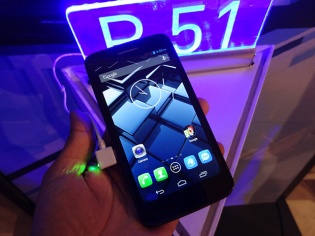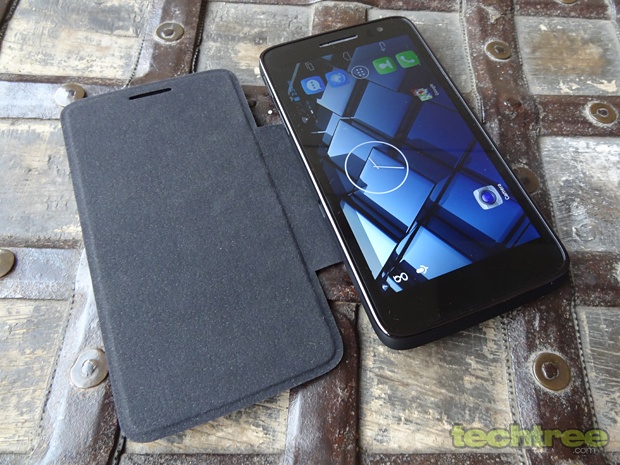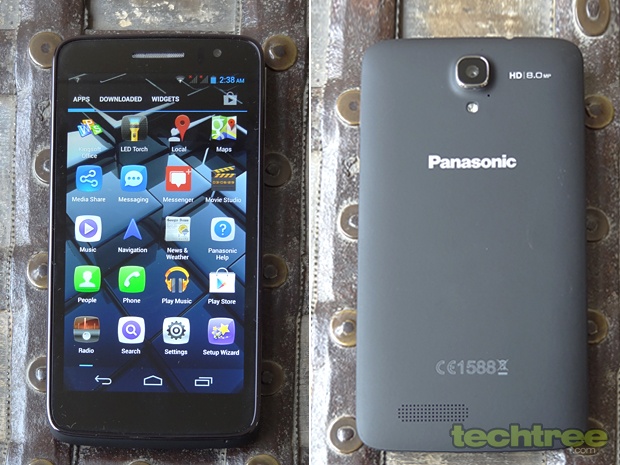-
Jayesh Limaye
18th May 2013
Panasonic has a wide range of consumer electronics products portfolio. We have known the company to manufacture televisions, cameras, camcorders, and even good old telephones. However, the company didn't really do anything in the smartphone segment in India till date while it is said to be enjoying a fifth of the handset market share in Japan. Panasonic has finally decided to take a plunge in the Indian market, which right now, is really a sea of brands, big and small. We had a chance to take a look at its debut Android handset Panasonic P51, which the company launched at an event in Delhi. Here are our first impressions.

Features
The P51 runs Android Jelly Bean and is powered by a 1.2 GHz quad-core MediaTek CPU. It sports a 5" HD IPS display with pixel dimensions of 1280x720. There is a rear camera with 8 mp image sensor having auto-focus and LED flash, capable of 1080p video recording. A 1.3 mp front camera is present for video chat.
Design And BuildAt 135 grams, the handset feels surprisingly lightweight when you consider that it is not small in size. The thickness is just 8.5 mm. One handed operation is difficult unless you have large hands. It has a black unibody casing with a soft-touch matte finish. This also means that you cannot replace the battery, which really is a non-issue because most users these days buy a new handset by the time the battery ages and stops working. Openings for microSD and dual-SIMs (probably the first dual-SIM phone with a unibody design), and micro-USB are along the periphery. It comes with a magnetic removable flip cover that protects the screen when not in use, but also covers the micro-USB port, thus preventing its use when the cover is attached and closed. Overall, the build quality is solid.
Screen
The 5" screen features scratch-resistant Asahi Dragontrail glass with an oleophobic treatment to remain smudge-free. In reality, the screen still gathers some fingerprints but significantly lesser than standard screens. The display quality is quite sharp and vibrant with wide viewing angles. The Panasonic P51 comes with a stylus, but the demo units didn't have any to test that input method. Looks-wise, the glass extends almost from edge to edge, with a thin rim having a shiny gunmetal finish. An odd thing that is noticeable is that the bottom bezel is around 1 cm thick and doesn't feature any control buttons — these are on the screen instead.
Camera
The rear 8 mp camera has features such as geolocation, scene and colour effects, ISO settings (100 to 1600), face detection, and even time lapse. The camera works in different modes such as Normal, face beauty, HDR, panorama, and multi-angle. These do seem to run as intended. There is a zero shutter delay setting which clicks photo as soon as you touch the shutter button, utilising continuous auto-focus. This is enabled by default and it seems to speed up the response time of the shutter. I must mention here that there is no dedicated shutter button and you have to depend on the capacitive one on the screen. The rear camera noticeably protrudes, which may or may not be according to the user's aesthetic taste, but it does provide some clearance for the speakerphone to sound clear.

OS and UI
The handset runs Android 4.2.1 (Jelly Bean) with almost no modifications. The overall experience is very smooth and lag-free as one should ideally expect from a quad-core handset with 1 GB of RAM. It continues to work smoothly even while multitasking. Apps run smoothly as well. The screen orientation feature works even on the home screen — a feature normally confined to tablets. The phone startup time is under half a minute and it improves to within 10 seconds when using the Quick start feature. A sore point is that the internal storage is 4 GB with only 1.22 GB left free for the user to play with. A 32 GB microSD card option is present though, thanks to the card slot.
Music and video playback (up to 1080p) had no issues. Panasonic also bundles along several apps such as CamCard, CamScanner, ET, Evernote, TOI, and WeChat. Here is a video of the P51 in action.
A Quick Recap
So here are our preliminary observations about the Panasonic P51. The handset features a dazzling and crisp display with great colours and wide viewing angles. It remains relatively smudge-free and can be cleaned up fast due to its oleophobic nature. The Android Jelly Bean works well without any noticeable lag even while multi-tasking. The phone sports a unibody design. It looks good and the build quality is very good too. However, the pricing of Rs 26,900, which is a bit too expensive, will make it a hard sell competing against cheaper competitors with a similar configuration. Mind you, these are just the initial impression based on a few minutes of usage. We will put up the in-depth review shortly. Once we put the P51 through the grind at our lab, we will know if it is worthy of its asking price.
Specifications:
- Android 4.2 (Jelly Bean), Google Play Store.
- Dual-SIM (GSM), Quad-band.
- 5" multi-touch capacitive IPS panel with pixel dimensions of 1280x720.
- Display protected by scratch-resistant Asahi Dragontrail glass.
- 1.2 GHz quad-core MediaTek MT6589 CPU, PowerVR Series5XT GPU.
- 1 GB RAM, 4 GB internal storage, MicroSD card slot.
- 8 megapixel autofocus camera with LED flash, 1.3 megapixel front-facing camera.
- Wi-Fi, 3G, Bluetooth 4.0, A-GPS, FM radio, 3.5 mm stereo jack.
- 2500 mAh battery.
- 5.7" (H) x 2.95" (W) x 0.33" (8.5 mm) (D), 135 grams.
Preview: Panasonic P51 Hands-on | TechTree.com
Preview: Panasonic P51 Hands-on
Preliminary observations about the company's first leap into the Android smartphone market.
News Corner
- DRIFE Begins Operations in Namma Bengaluru
- Sevenaire launches ‘NEPTUNE’ – 24W Portable Speaker with RGB LED Lights
- Inbase launches ‘Urban Q1 Pro’ TWS Earbuds with Smart Touch control in India
- Airtel announces Rs 6000 cashback on purchase of smartphones from leading brands
- 78% of Indians are saving to spend during the festive season and 72% will splurge on gadgets & electronics
- 5 Tips For Buying A TV This Festive Season
- Facebook launches its largest creator education program in India
- 5 educational tech toys for young and aspiring engineers
- Mid-range smartphones emerge as customer favourites this festive season, reveals Amazon survey
- COLORFUL Launches Onebot M24A1 AIO PC for Professionals







TECHTREE